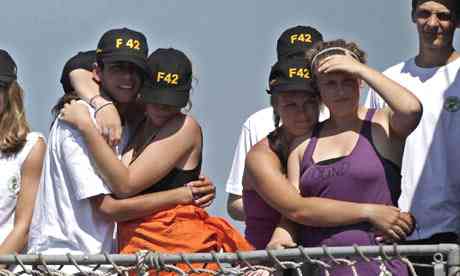
Students discovered from high Atlantic seas after the their vessel the Concordia capsized are brought ashore in Rio de Janeiro Photograph: Felipe Dana/AP
Dozens of students, together with 3 British teenagers, were left floating on hold up rafts in the Atlantic for scarcely dual days after their vessel sank off the seashore of Brazil.
Sarah Calascione, 19, Nicole Turner, 18, and Gabriella Haines, 16, were between 41 students and twenty-three organisation aboard the SV Concordia, a 57-metre prolonged sailing vessel that capsized in bad continue off the seashore of Rio de Janeiro last Wednesday.
They scrambled for lifeboats and outlayed 40 hours in torrential sleet and surging waves prior to being discovered by the Brazilian navy, that has been criticised over the rescue operation.
"I didn"t think we were going to be rescued. It was horrible," pronounced Calascione, who assimilated the ship, that set cruise from Canada last September, dual weeks ago. "The air wave apparatus was shop-worn so we usually had an EPIRB [distress beacon] that sends out a heavenly body signal, but that wasn"t picked up true away. It wasn"t until thirty hours after that a watchman craft saw the hold up raft."
The ship"s operators, the Nova Scotia-based West Island College International, pronounced they were watchful for sum of the rescue response. "We unequivocally don"t have the answers as to because opposite decisions were done with the Brazilian rescue or with the army at assorted times," the college president, Nigel McCarthy, told the Canadian Broadcasting Corporation.
SV Concordia capsized during a microburst – a singular and remarkable downdraft of air in a small area – on Wednesday afternoon, about 300 miles off Brazil.
A mouthpiece for the Brazilian navy, Maria Padilha, pronounced that naval responders perceived a trouble vigilance about 10pm internal time on Wednesday and attempted to have air wave hit with the vessel.
They additionally communicated with circuitously ships and aircraft to see if they could mark anything wrong in the area, she said.
But it was not until late the subsequent day that a watchman aircraft located the hold up rafts.
The cruise vessel left Recife in north-east Brazil on 8 Feb and was sailing to Montevideo, Uruguay"s capital, where it was due to arrive on twenty-five February, as piece of a 10-month voyage. The vessel had already visited Ireland, the Mediterranean and north-west Africa.
The Canadian college"s category afloat programme offers propagandize and university credits for students embarking on a prolonged voyage, on vacation thirty ports in at slightest twenty countries. The outing costs £25,000 each.
Calascione was used to the sea after sailing with her relatives from Malta to Australia as a child. She is due to begin a story grade at Exeter University in September.
"We were told there had been a trouble vigilance and watchman planes and army boats had been deployed but there was no pointer of the Concordia," her mother, Caroline Calascione, said. "It was a really nerve-racking and romantic experience. It wasn"t until we perceived a phone call from Sarah on Saturday that we knew she was safe.
The ship"s captain, William Curry, pronounced the Concordia"s organisation had rebuilt a day previously for what they expected would be severe but not surprising weather. He was next rug when the vessel unexpected keeled – that was normal. But it was when it keeled a second time that he knew the vessel was in good danger.
A Brazilian naval vessel took about 10 students behind to seaside on Saturday with the rest nearing on businessman vessels.
"We had been in the hold up raft for about thirty hours when we saw a poke craft for the initial time," pronounced 16-year-old Lauren Unsworth, a Dutch-Canadian newcomer who lives in Amsterdam. "That"s when we knew we were not alone and that assistance was on the way."
She added: "The vessel proposed keeling a lot. It came behind up, keeled again, was fundamentally lying on the side and all the windows began to break. That"s when we knew it was time to flee."
Edgardo Ybranez, captain of the Philippine flagged load vessel that discovered 44 people, pronounced everybody from the Concordia was unhurt solely for the doctor, who suffered an damage prior to the rescue "but he is OK now." Ybranez gave no some-more details.
No comments:
Post a Comment